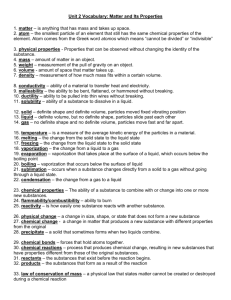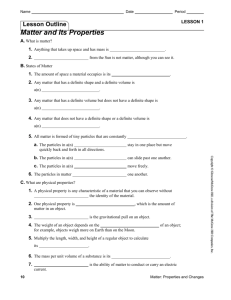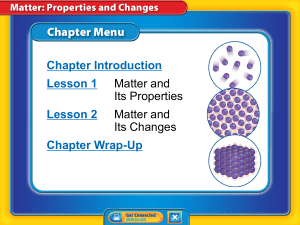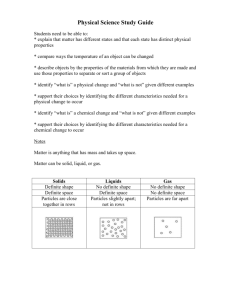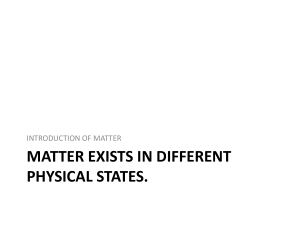Chapter 5 Review Power Point
advertisement
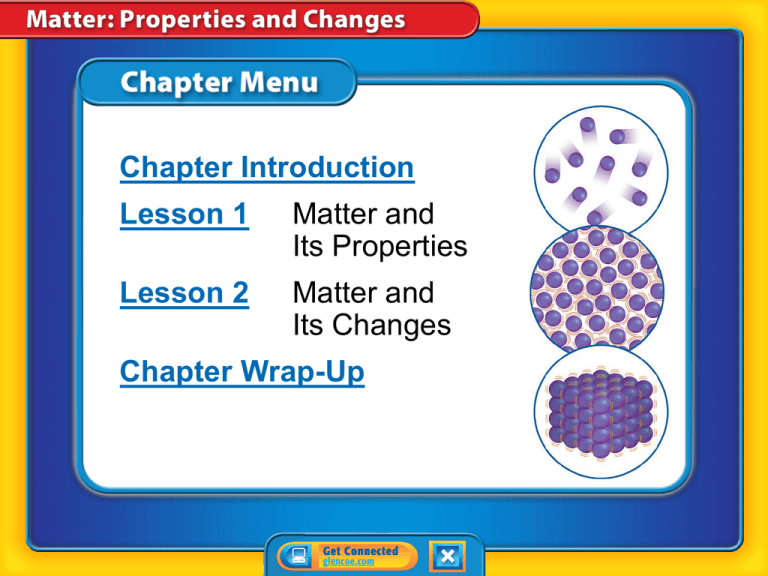
Chapter Introduction Lesson 1 Matter and Its Properties Lesson 2 Matter and Its Changes Chapter Wrap-Up What gives a substance its unique identity? What do you think? Before you begin, decide if you agree or disagree with each of these statements. As you view this presentation, see if you change your mind about any of the statements. Do you agree or disagree? 1. The particles in a solid object do not move. 2. Your weight depends on your location. 3. The particles in ice are the same as the particles in liquid water. Do you agree or disagree? 4. Mixing powdered drink mix with water causes a new substance to form. 5. If you combine two substances, bubbling is a sign that a new type of substance might be forming. 6. If you stir salt into water, the total amount of matter decreases. Matter and Its Properties • How do particles move in solids, liquids, and gases? • How are physical properties different from chemical properties? • How are properties used to identify a substance? Matter and Its Properties • volume • mass • solid • density • liquid • solubility • gas • chemical property • physical property What is matter? • Matter is anything that has mass and takes up space. • Matter can have both physical and chemical properties. States of Matter • Volume is the amount of space a sample of matter occupies. • A solid is a state of matter with a definite shape and volume. • A liquid is a state of matter with a definite volume but not a definite shape. • A gas is a state of matter without a definite shape or a definite volume. States of Matter (cont.) • All matter is made of tiny particles that are constantly moving. • In solids, particles vibrate back and forth in all directions. States of Matter (cont.) In liquids, the distance between particles is greater and they can slide past one another. States of Matter (cont.) In a gas, particles move freely rather than staying close together. States of Matter (cont.) How do particles move in solids, liquids, and gases? States of Matter (cont.) • Particles of matter that are close together exert an attractive force on each other. • The strength of the attraction depends on the distance between particles. What are physical properties? • Any characteristic of matter that you can observe without changing the identity of the substances that make it up is a physical property. • State of matter, temperature, and the size of an object are all examples of physical properties. What are physical properties? (cont.) state Science Use a condition or physical property of matter Common Use an organized group of people in a defined territory, such as one of the fifty states in the United States Mass is the amount of matter in an object. Hutchings Photography/Digital Light Source What are physical properties? (cont.) • Weight is the gravitational pull on the mass of an object. • Weight depends on the location of an object, but its mass does not. Hutchings Photography/Digital Light Source Volume depends on the amount or size of the sample of matter. What are physical properties? (cont.) • Density is the mass per unit volume of a substance. • Density is constant for a given substance, regardless of the size of the sample. What are physical properties? (cont.) Solubility is the ability of one material to dissolve in another. solubility from Latin solubilis, means “capable of being dissolved” What are physical properties? (cont.) • Melting point and boiling point are physical properties. • The melting point is the temperature at which a solid changes to a liquid. • The boiling point is the temperature at which a liquid boils, or changes to gas. • Magnetism, malleability, and electrical conductivity are also physical properties. What are chemical properties? • A chemical property is the ability or inability of a substance to combine with or change into one or more new substances. • A chemical property is a characteristic of matter that you observe as it reacts with or changes into a different substance. What are chemical properties? (cont.) How do chemical properties and physical properties differ? What are chemical properties? (cont.) • Flammability and the ability to rust are both chemical properties. • Flammability is the ability of a type of matter to burn easily. • Rust is a substance that forms when iron reacts with water and oxygen. Identifying Matter Using Physical Properties • Physical properties are useful for identifying unknown substances. • When you identify matter using physical properties, consider how the properties are alike and how they are different. Identifying Matter Using Physical Properties (cont.) How are properties used to identify a substance? Sorting Materials Using Properties Physical properties and chemical properties are useful for sorting materials. Separating Mixtures Using Physical Properties Physical properties, such as a material’s melting point, are useful for separating different types of matter that are mixed. • The movement of particles is different in a solid, a liquid, and a gas. • Physical properties and chemical properties are used to describe types of matter. Hutchings Photography/Digital Light Source Hutchings Photography/Digital Light Source • Physical properties such as magnetism can be used to separate mixtures. Which of these refers to a state of matter with a definite volume but not a definite shape? A. particle B. solid C. gas D. liquid What is the amount of space a sample of matter occupies? A. mass B. volume C. weight D. density Solubility refers to one substance’s ability to do what in the presence of another substance? A. rust B. burn C. dissolve D. change shape Do you agree or disagree? 1. The particles in a solid object do not move. 2. Your weight depends on your location. 3. The particles in ice are the same as the particles in liquid water. Matter and Its Change • How are physical changes different from chemical changes? • How do physical and chemical changes affect mass? Matter and Its Change • physical change • chemical change • law of conservation of mass What are physical changes? • Matter can change in many physical and chemical ways. • A change in the size, shape, form, or state of matter that does not change the matter’s identity is a physical change. • When a physical change occurs, the chemical properties of the matter stay the same. Hutchings Photography/Digital Light Source Dissolving: A Physical Change What are physical changes? (cont.) • Changes in the state of matter are physical changes. • Melting and boiling are both changes in state. • Changes in energy cause changes in the state of matter. Hutchings Photography/Digital Light Source What are chemical changes? • A chemical change is a change in matter in which the substances that make up the matter change into other substances with different chemical and physical properties. • The new substance produced during a chemical change has different chemical and physical properties. What are chemical changes? (cont.) The only sure sign of a chemical change is the formation of a new substance. How are chemical changes different from physical changes? What are chemical changes? (cont.) • For many reactions, changes in physical properties, such as color or state of matter, are signs that a chemical change has occurred. • All chemical reactions involve energy changes. • Thermal or light energy is often needed for a chemical reaction to take place. What are chemical changes? (cont.) • Most chemical changes cannot be reversed. • Some physical changes can be easily reversed, but others cannot. What are chemical changes? (cont.) The law of conservation of mass states that the total mass before a chemical reaction is the same as the total mass after the chemical reaction. conservation from Latin conservare, means “to keep, preserve” What are chemical changes? (cont.) How do physical and chemical changes affect mass? Comparing Physical and Chemical Changes • Sometimes deciding if a change is physical or chemical is easy, but often many factors must be compared and considered. • Chemical changes produce a new substance, but physical changes do not. • The identity of a substance does not change during a physical change such as a change in the state of matter. Hutchings Photography/Digital Light Source • A new substance is produced during a chemical change. • The law of conservation of mass states that the mass of a material does not change during a chemical change. Which of these processes is a physical change in which the identities of the substances do not change when they are mixed? A. rusting C. color change B. burning D. dissolving The only sure sign of a chemical change is the formation of which of the following? A. liquid B. precipitate C. a new substance D. gas Which law states that the total mass before a chemical reaction is the same as the total mass after the chemical reaction? A. conservation of mass B. conservation of volume C. conservation of matter D. conservation of size Do you agree or disagree? 4. Mixing powdered drink mix with water causes a new substance to form. 5. If you combine two substances, bubbling is a sign that a new type of substance might be forming. 6. If you stir salt into water, the total amount of mass decreases. Key Concept Summary Interactive Concept Map Chapter Review Standardized Test Practice Physical and chemical properties give a substance its unique identity. The matter that makes up a substance can change physically or chemically. Lesson 1: Matter and Its Properties • Particles of a solid vibrate about a definite position. Particles of a liquid can slide past one another. Particles of a gas move freely within their container. • A physical property is a characteristic of matter that you can observe without changing the identity of the substances that make it up. A chemical property is the ability or inability of a substance to combine with or change into one or more new substances. • Some properties of matter do not depend on size or amount of the sample. You can identify a substance by comparing these properties to those of other known substances. Lesson 2: Matter and Its Changes • A change in the size, shape, or form of matter in which the identity of the matter stays the same is a physical change. A change in matter in which the substances that make it up change into other substance with different chemical and physical properties is a chemical change. • The law of conservation of mass states that the total mass before a chemical reaction is the same as the total mass after the reaction. Which of these is a state of matter without a definite shape or volume? A. liquid B. gas C. solid D. chemical What term describes any characteristic of matter that you can observe without changing the identity of the substances it’s made of? A. physical property B. chemical property C. density D. weight Color change can be an indication of which of these? A. a physical change B. a chemical change C. a chemical or physical change D. no change During a physical change what characteristic of matter changes? A. chemical properties B. colors C. physical properties D. density When a substance is heated to its boiling point, the bubbles indicate that liquid is turning into which of these? A. a gas B. a new liquid C. a solid D. a precipitate What term describes anything that has mass and takes up space? A. water B. gas C. matter D. a solid Depending on the size and shape of its container, a gas changes both shape and which of the following? A. volume B. color C. mass D. density Which refers to a change in a substance where no new substances are formed? A. physical change B. conservation of mass C. chemical change D. physical and chemical change What kind of change has occurred when substances change into other substances? A. physical B. color C. chemical D. identity What is another name for a chemical change? A. melting B. boiling C. physical reaction D. chemical reaction
